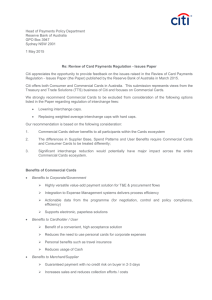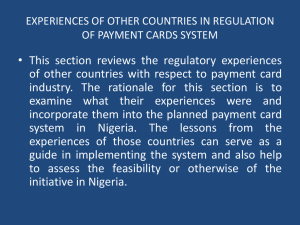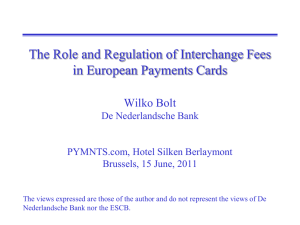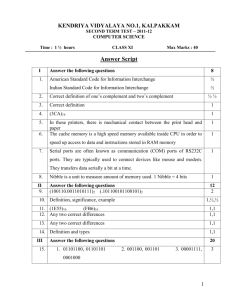THE PRELIMINARY CONCLUSIONS OF THE PAYMENTS SYSTEM REVIEW
advertisement
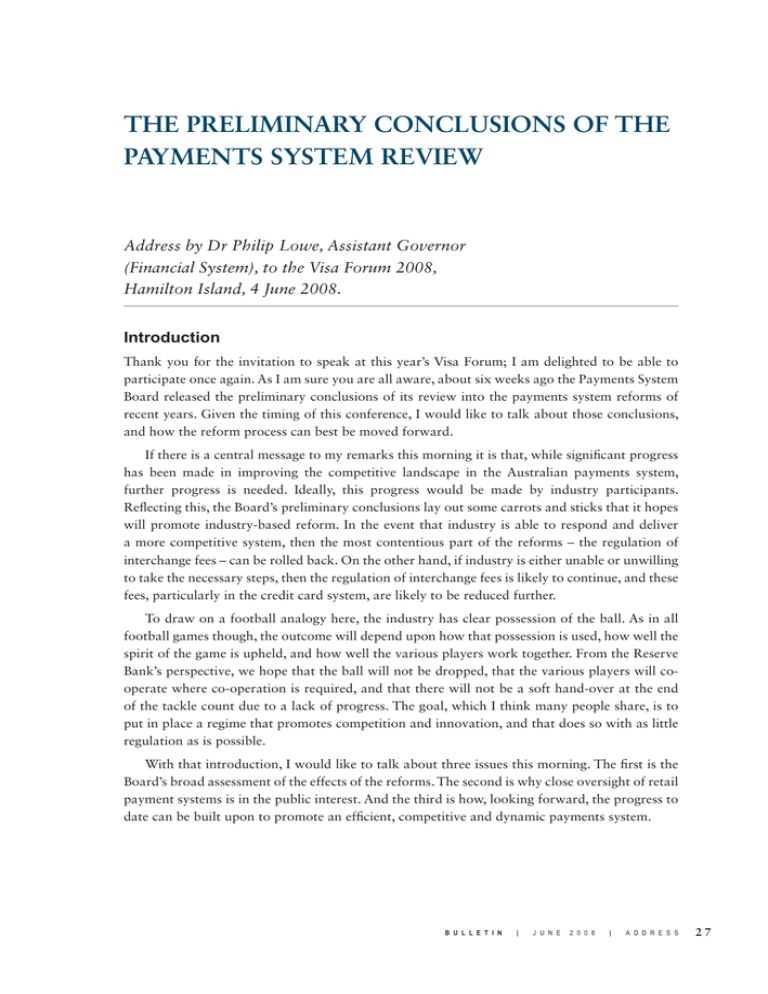
THE PRELIMINARY CONCLUSIONS OF THE PAYMENTS SYSTEM REVIEW Address by Dr Philip Lowe, Assistant Governor (Financial System), to the Visa Forum 2008, Hamilton Island, 4 June 2008. Introduction Thank you for the invitation to speak at this year’s Visa Forum; I am delighted to be able to participate once again. As I am sure you are all aware, about six weeks ago the Payments System Board released the preliminary conclusions of its review into the payments system reforms of recent years. Given the timing of this conference, I would like to talk about those conclusions, and how the reform process can best be moved forward. If there is a central message to my remarks this morning it is that, while significant progress has been made in improving the competitive landscape in the Australian payments system, further progress is needed. Ideally, this progress would be made by industry participants. Reflecting this, the Board’s preliminary conclusions lay out some carrots and sticks that it hopes will promote industry-based reform. In the event that industry is able to respond and deliver a more competitive system, then the most contentious part of the reforms – the regulation of interchange fees – can be rolled back. On the other hand, if industry is either unable or unwilling to take the necessary steps, then the regulation of interchange fees is likely to continue, and these fees, particularly in the credit card system, are likely to be reduced further. To draw on a football analogy here, the industry has clear possession of the ball. As in all football games though, the outcome will depend upon how that possession is used, how well the spirit of the game is upheld, and how well the various players work together. From the Reserve Bank’s perspective, we hope that the ball will not be dropped, that the various players will cooperate where co-operation is required, and that there will not be a soft hand-over at the end of the tackle count due to a lack of progress. The goal, which I think many people share, is to put in place a regime that promotes competition and innovation, and that does so with as little regulation as is possible. With that introduction, I would like to talk about three issues this morning. The first is the Board’s broad assessment of the effects of the reforms. The second is why close oversight of retail payment systems is in the public interest. And the third is how, looking forward, the progress to date can be built upon to promote an efficient, competitive and dynamic payments system. B U L L E T I N | J U N E 2 0 0 8 | A D D R E S S 27 The Impact of the Reforms As part of the Review, the Bank has consulted widely with industry participants. It has listened carefully to the various views, it has sought evidence and analysis from industry participants, and it has conducted extensive studies on payments patterns and costs. This consultation process has confirmed something that was already well known – that is, that perspectives differ greatly on the impact of the reforms: what one group strongly supports, another strongly opposes. The Board has sought to weigh these often diametrically opposed views and, consistent with its mandate, to draw conclusions about what is in the public interest, as opposed to the commercial interests of the various parties in the payments system. As I hope is now well understood, the various reforms have had a number of intermediate objectives. These include: • improving price signals to cardholders; • increasing transparency; • improving access arrangements; and • removing restrictions on merchants that limit competition. The ultimate objective has, of course, been to promote competition and efficiency in the Australian payments system. In the Board’s judgment, significant progress has been made in each of these areas. The competitive environment has been improved. Merchants have more choice. The veil of secrecy on interchange fees has been lifted. Access has been liberalised. And the price signals to consumers have been improved. The result has been substantial welfare gains to the community at large, although as with all micro-economic reforms the benefits and costs have not fallen equally across the population. Notwithstanding this progress, the Board has identified a number of areas where more work is required. The first of these is the general competitive environment in which interchange fees are set. While the competitive forces acting on these fees have been strengthened as a result of the reforms, the Board remains of the view that these forces are relatively weak. One piece of evidence in support of this is that the weighted-average interchange fees in the various regulated systems are all above the 2006 benchmarks, and have tended to rise over the past year. In addition, both MasterCard and Visa have argued at different times that they are at a competitive disadvantage because they can’t have higher interchange fees. A reasonable reading of the evidence suggests that the competitive dynamics are still for higher, not lower, interchange fees. The second area is that of access arrangements. While the access regimes and the EFTPOS access code have improved things somewhat, access to Australia’s bilateral payment systems remains both unnecessarily difficult and costly. The Board is encouraging industry participants, as a matter of priority, to address this issue and to develop arrangements that avoid new entrants having to conduct negotiations with most, or all, incumbents before they can enter. The third area is transparency. The Australian payments system is much more transparent than it was a few years ago – Visa’s recent decision to put its operating rules on its website is the 28 R E S E R V E B A N K O F A U S T R A L I A latest example of this improvement. More, however, can be done. In particular, the Board sees a strong case for the schemes to publish their weighted-average interchange fees on a regular basis, as well as details of their scheme fees. Ideally, this would be done voluntarily although, if this does not happen, the Board will consider requiring the schemes to publish additional information. On interchange fees, the paper setting out the Board’s conclusions discusses a number of options and I would like to talk about those in a few minutes. But before I do so, I would like to say a few words about the second of my three topics – that is why continued close oversight of competition in retail payment systems is in the public interest. Why Close Oversight is in the Public Interest Throughout the review process, a frequent question has been what is the market failure or distortion that interchange regulation is attempting to address? This is a very good question and, as a number of submissions have pointed out, is a logical starting point for thinking about the need for either regulation or oversight. In short, the answer is that there is a significant distortion on the merchant side. In particular, merchants are willing to pay more, in aggregate, for some payment instruments than the benefit they receive. This is contrary to what normally happens in a well-functioning market, where the amount that somebody is prepared to pay is limited by the benefit they receive. For example, if I value a haircut at $25, I will pay $24, but I will not pay $26. In general, if people pay more for something than it’s worth to them, there is a strong prima facie case that something is not working as it should. So why is it that merchants are prepared to pay more in aggregate for some payment instruments than the benefit they receive? After all, just as I won’t pay more for a haircut than it’s worth to me, it makes no sense for an individual merchant to accept credit cards if the benefit it gets is less than the cost. The answer is that part of the perceived benefit of accepting credit cards is that the merchant attracts business from other merchants; the so-called ‘business-stealing’ incentive. But the sum of these individual benefits does not equal the aggregate benefit. This is because merchants, in aggregate, can’t steal business from themselves: one merchant’s gain is another’s loss. Now some industry participants have contested this idea, arguing that the acceptance of credit cards increases aggregate sales significantly. This is not a view that the Board has accepted, as ultimately consumer spending is tied down by income. In making this point, however, I want to make it clear that I am not saying that credit cards do not have benefits for merchants – they clearly do. One of these benefits is that they can bring forward the timing of sales. Another is that they can deliver operational efficiencies. However, the key point here is that the sum of any individual perceived benefits is less than the aggregate benefit. In a sense, merchants are caught in the classic ‘prisoners’ dilemma’. They would be better off if they could talk to one another, collectively agreeing on the terms of credit card acceptance, paying no more than their collective benefit. Instead, they are forced to act individually and, as a result, can end up paying more than the collective benefit they receive. Historically, this B U L L E T I N | J U N E 2 0 0 8 | A D D R E S S 29 basic distortion has been reinforced by a lack of transparency over fees and by restrictive rules that limited the choices available to merchants. The result has been that the normal forces of competition have not worked well on interchange fees. One solution here would be to allow merchants to collectively negotiate with the schemes over these fees. While this solution has not been under active discussion in Australia, it has been considered in the United States. Indeed, one proposal working its way through the Congress’ legislative processes is to exempt merchants from trade practices legislation to allow them to collectively negotiate. Without wishing to comment on the merits of this legislation, it can be seen as one way of overcoming the basic distortion that can exist in payment systems. Another significant factor affecting the competitive landscape in Australia is the governance arrangements for the EFTPOS system. Unlike the credit card systems, EFTPOS is built around a series of bilateral links between financial institutions. There is no central entity responsible for development and promotion of the system, or for the setting of interchange fees. These arrangements have meant that the EFTPOS system is at a structural disadvantage in competing with the international card schemes. This structural disadvantage has been compounded by the way that interchange fees are set – that is, flowing from the cardholder’s bank to the merchant’s bank. While this overall structure may have been helpful in the original development of the system, it has limited the ability of the EFTPOS system to compete and to innovate. So to summarise, there are significant co-ordination issues in the payments system. Merchants can’t co-ordinate in negotiation with the card schemes and financial institutions have had difficulty co-ordinating to develop the EFTPOS system. These co-ordination problems have, in the Board’s view, distorted competition in the payments system. As has been discussed on numerous occasions, they have led to price signals to many consumers that encourage credit card use at the expense of debit card use. In particular, the willingness of merchants to pay more than their collective benefit for credit card acceptance has resulted in many credit card users facing negative effective prices. And the governance problems in the EFTPOS system have led to larger differences in interchange fees between the debit and credit card systems than might otherwise have occurred. All this means that there are legitimate public policy concerns about the nature of competition in the Australian payments system, and that close oversight is required. Of course this oversight need not extend to regulation by the Reserve Bank. Ideally, industry participants would take the necessary steps to address the Board’s concerns, and we have seen some examples of this over recent years. These include the EFTPOS access code, the ATM reforms, MasterCard’s changes to its honour-all-cards rule and its limit on its debit card interchange fees, and the removal of the no-surcharge rules by American Express and Diners Club. The Board strongly encourages others to consider this approach. I would now like to turn to the third issue: where do we go from here? 30 R E S E R V E B A N K O F A U S T R A L I A Where to from Here? The most contentious issue is obviously interchange fees. But before I talk about the Board’s conclusions here I would like to say a few words about other parts of the reform process that have worked to improve the competitive environment. The first of these is greater transparency. Markets work best if there is a high level of disclosure and everyone understands the rules of the game. As I said earlier, things have improved here over recent years and the Board is now encouraging MasterCard and Visa to take further steps to improve the transparency of their various fees. The Bank would welcome the opportunity to work with the schemes to develop arrangements that provide the necessary information to merchants, while at the same time protecting data that are legitimately commercially confidential. The second aspect of the reforms that has helped promote competition is an increase in the choices available to merchants. Here the removal of the no-surcharge rule and the modification to the honour-all-cards rule have been important. The Board sees absolutely no case for reversing these reforms. The growing prevalence of surcharging for credit card transactions has clearly promoted better price signals in the payments system, particularly for bill payments. While some merchants remain reluctant to surcharge, particularly in a face-to-face environment, the culture against surcharging is changing and is doing so faster than many had expected. According to the surveys conducted for the Bank, the number of merchants surcharging is steadily increasing, and many merchants indicate that they are currently considering introducing a surcharge. In fact, during the review process, a number of industry participants have argued that surcharging has become sufficiently commonplace that the Board need no longer be concerned about interchange fees. The Board, however, is not convinced that this is the case. While the increasing use of surcharging is a welcome development, the Board’s judgment is that the practice is not yet sufficiently pervasive to allow it to remove the regulation of interchange fees unconditionally. Notwithstanding this view, the increasing use of surcharging is clearly changing the competitive landscape. It is one reason that the combined market share of American Express and Diners Club has shown little change over the past few years, despite these schemes offering more attractive rewards to some cardholders. Surcharging has also led to downward pressure on some classes of interchange fees, and downward pressure on merchant service fees for the three-party schemes. This change in the competitive environment has been discussed extensively at recent meetings of the Payments System Board. The key question is whether the nature of the competitive forces in the payments system are such that regulation is inevitably required indefinitely, or could further changes be made to that environment to allow interchange regulation to be removed? This is a difficult question, and respectable arguments can be made both ways. On the one hand, the competitive forces in the payments system are unusual. As I have discussed, a clear distortion exists on the merchant side. This distortion cannot be easily overcome, with the evidence suggesting that upward pressure on interchange fees remains. On the other hand, the reforms have improved the competitive environment and regulation does involve some costs. B U L L E T I N | J U N E 2 0 0 8 | A D D R E S S 31 In addition, the Board’s general predisposition is to use regulation only as a last resort after industry-based processes have failed. While the arguments are finely balanced, the Board has indicated its willingness to remove the regulation of interchange fees, but only on the condition that additional steps are taken to further improve the competitive landscape. Given the distortion that exists on the merchant side, the competitive environment needs to be as strong as possible if we are to have reasonable confidence that, left to themselves, interchange fees will be set at levels that promote the efficiency of the overall system. The preliminary conclusions set out a number of possible steps that could be taken by industry participants to strengthen the competitive environment. These include: changes to the EFTPOS system; further modifications to the honour-all-cards rule; and greater transparency of scheme fees. Perhaps the most significant of these is the possibility of changes to the EFTPOS system. These changes include: i. the introduction of a scheme to replace existing bilateral contracts, with the scheme able to make decisions about multilateral interchange fees; ii. the creation of effective arrangements to promote the development of the scheme; iii. further reform of access arrangements; and iv. the development of alternative payment methods for use in online payments, particularly those made to domestic merchants. This could be within the existing EFTPOS system, or through other online payment systems, including for example, the Mambo system proposed by BPAY. In effect, the Board is saying that it would like to see an effective competitor to the international card schemes. Strong competition is likely to provide greater choice for both merchants and consumers, and may well lead to lower prices for payments services and more innovation. If such competition does not exist, the Board sees a strong case for the continued regulation of interchange fees, particularly in the absence of a significant further increase in surcharging. These suggested reforms focus on the EFTPOS system, reflecting the important role that this system plays in Australia. The fact that the Board has focused on this system should, however, not be seen as it offering some implicit protection of the EFTPOS system; all payment systems need to compete on their merits. Rather, it reflects a view that a revitalised EFTPOS system could provide the strong competition that is needed going forward. Of course, in time, other payment systems might emerge to play that role. The Board sees a number of potential advantages of pursuing this option and allowing the schemes to set their own interchange fees within the context of a strengthened competitive environment. One is that it would allow the schemes more flexibility to compete with one another, and this extra flexibility may help promote innovation. Another is that the distortions that can arise when people attempt to game, or circumvent, the regulations are avoided. And a third is that the compliance costs are reduced, although these are estimated to be relatively small. 32 R E S E R V E B A N K O F A U S T R A L I A In indicating its willingness to step back, I want to make very clear that the Board is not saying that the regulation of interchange fees has been a mistake. Indeed, the reverse is the case. The Board is only now able to consider this option because of the strengthening of the competitive forces that has occurred, and the fact that regulation has already significantly narrowed the difference in interchange fees between the various systems. It is very much about building on the progress that has been achieved so far. It is also important to point out that the Board would consider the reimposition of interchange regulation if average interchange fees in the credit card system were to rise materially again. This reflects the view that the arguments for higher credit card interchange fees than currently exist are weak. An increase in average fees from current levels would be likely to indicate to the Board that despite the various reforms, insufficient competitive forces had been able to be brought to bear on these fees. One possibility that the schemes might explore here is to provide some sort of public commitment that their average interchange fees will be no higher than, say, the current 0.5 per cent benchmark for a number of years. I note here that in other countries, the schemes have agreed to cap their interchange fees, following discussions with the relevant authorities. In terms of timelines, the Board’s current intention is to take stock of developments at its August 2009 meeting. If at that time, it judges that insufficient progress has been made, its current thinking is that interchange regulation would continue, with the preliminary conclusions setting out its thinking on the nature of the likely regulation. In particular, a common interchange fee of perhaps five cents flowing to the cardholder’s bank is envisaged in both the EFTPOS system and the scheme debit system, and average credit card interchange fees would be likely to be reduced from around 0.5 per cent to around 0.3 per cent. The reasons for this particular configuration are set out in the preliminary conclusions. These new fees would probably come into effect in early 2010. Conclusion Let me close by trying to bring the various pieces together by making three points. The first is that in the Board’s view, the reforms have largely met their objectives. The removal of restrictions on merchants, the increase in transparency, and the more liberal access arrangements have all strengthened the competitive environment. The Board sees absolutely no case for winding back the reforms in any of these areas. Indeed, it has suggested additional steps that would give merchants even more choice, that would further improve transparency, and that would reduce the cost of access. The second point is that despite this change in the competitive environment, the Board remains concerned about the competitive dynamics that can exist in the payments system. These concerns largely stem from the structure of the incentives facing merchants and are compounded by the current governance arrangements in the EFTPOS system. These structural characteristics mean that oversight of retail payments remains in the public interest. And the third and final point is that the Board is prepared to step back from interchange regulation if the industry is prepared to step forward. The Board would, however, consider B U L L E T I N | J U N E 2 0 0 8 | A D D R E S S 33 re-regulation if, after having stepped back, interchange fees were to subsequently rise materially. It does not see a case for higher average interchange fees in the credit card system than currently exist. So, as I said at the outset, the ball is in the industry’s hands. We hope that you are able to run with it and use that possession well! Thank you. 34 R E S E R V E B A N K R O F A U S T R A L I A

